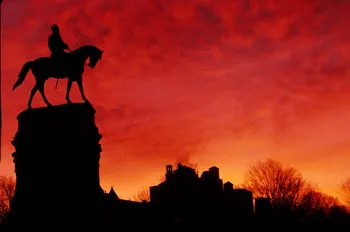
By Chris E. Heisey
For a number of years I have had the distinct pleasure of being one of the judges in the annual Civil War Trust photo contest. Every year it is a joy exploring the images, trying to decide which I feel should be the winners. It is purely a subjective call and there is always a pang of uneasiness while judging. What separates the winning images from the rest is not always obvious.

I thought it might be a good idea to offer some feedback and pointers to all Civil War Trust shooters who love battlefields and enjoy photographing our hallowed sites. While photography can be quite a technical science with f-stops, filters and hyperfocal distance, that is not its essence. And with the complete emergence of digital shooting, all the pixel gizmos and gadgets can bog down the avid photographer even more. Make no mistake – learning digital technologies is a must, yet there is much more that makes photography art.
Photography is a craft. It is elusive to master; however, I find that when my focus is on my quality of light, preparedness, perspective, atmospherics and passion, my images get all the better.
Some 20 years ago, I started visiting Civil War battlefields in earnest. After watching the Ken Burns PBS series, The Civil War, it was not the thousands of black and white images woven together that caught my eye as much as it was the wonderful color contemporary imagery that powerfully spoke to me. One of the images seared in my mind was a somber shot of mist rolling along Chickamauga Creek. That’s neat, I thought, maybe I should try that sort of photography.
Having visited some 350 battlefields since that time I agree totally with Joshua Lawrence Chamberlain that something still abides on our sacred battlefields. Oftentimes on a battlefield, I will see another photographer with a Civil War Trust cap or shirt trying to capture that image that says more than it shows. And that makes me smile.
Light
Great photography is all about great light. I love mornings and often find the first light of the day to be the sweetest. Many of the images entered in the photo contest were composed with artful eye and technical merit (sharp focus and exposed properly), yet were missing quality lighting. Battlefields have the most visitors during the mid-day hours when the sun angle is at its highest. Almost always, the lower the sun’s angle, the better your light. So why not shoot while others are having breakfast?

Appomattox Court House is some 200 miles from my home in Pennsylvania. I visited this hallowed spot some 10 years ago in mid-day light. Not long ago, instead of getting up at 5 a.m. and making the trip, I got up two hours earlier and drove my four hours to be there when the light would be that extra bit better.
Light is the first way to distinguish oneself in photography. Show up and be there when the light is at its optimum and your chances of a dramatic photo go up dramatically.
Be Prepared
A day after the Sept. 11 terrorist attacks, feeling somber, I trekked down to Harpers Ferry National Historical Park to climb Maryland Heights, which tower above the town. The fog was thick as the sun rose and the town and vista below were completely obscured when the light was sweet. Disappointed, I sat on the rocks with my camera packed away, moping a bit as the optimum light was fading amidst the shroud. Suddenly I heard a swoosh and a clap, then another. Out of the fog appeared a mature female bald eagle, flying majestically toward me out of the fog. I scrambled for my camera as she disappeared. As I fought with my photo backpack, she came out of the fog again and flew right beside me, her eagle eye boldly peering from her stark, white head. She was so close that I could have hit her with my tripod.
I learned a big lesson that day about being ready. Most great images are missed because we do not have the camera with us. We stow it away in our bags or forget it in the hotel. That’s a form of laziness that I am guilty of too often. Carry your camera with you at all times in ready mode, and your chances of capturing a winner increase markedly.
Perspective
One of the greatest challenges of photography is perspective. If you enter a photo contest, you must believe that you are offering something fresh. I read in a photography magazine that since the invention of photography just prior to the Civil War, it is estimated that some 12 trillion images have been shot. Now that nearly all of us are shooting using digital technologies, I would guess that this number will double rather soon given the ease of hitting the delete button.
While happily working on the book In the Footsteps of Grant and Lee: Wilderness to Cold Harbor with Overland Campaign authority and author Gordon Rhea, it was my goal to find new ways to look at these great Virginia battlefields. Threatened by sprawl as they are, there are still many wonderful sites that feel like 1864. How to depict the North Anna River was one of my greatest challenges, so I decided to make it one of my first attempts.
Standing on the river’s bank at Lee’s Ox Ford salient on a 28-degree October morning, I decided to wade out into the rushing river. With my camera on a tripod and water rushing across my chest, I shot an image that spoke to how the river was a barrier.
Finding your own perspective is important to growing as a photographer. Everybody is different, and that’s why you should take more photos.
Atmospherics
At one of my recent book signings, I had older gentleman open one of my books and say with a smile, “That’s a Heisey photo there.” Playing dumb, I replied, “Why so?”

“The weather must have been awful – icy, cold and gloomy. That’s your signature.”
I had never really given it that much thought, but he was correct. I love shooting when the weather is terrible – pouring rain, driving snow, frigid temps, foggy mornings. The more I learn about weather, and its effect on light and the landscape, the better my images seem to speak. Bad weather is good weather.
Many contest images are taken on sunny days. If your goal is to stand out, it might not hurt to shoot in weather that others find unappealing.
Passion
No way can I explain what passion is. For sure I feel passion for photography and Civil War battlefields. Finding a spider web, or experiencing a blood red sunset where battle raged 150 years ago makes my heart pound. But passion is something more.
Not long after I started photographing battlefields, I traveled the few miles from my home to Gettysburg. It was July 3 and at 6 a.m., it was already in the mid-80s. I like it hot.
As I shot near the Virginia Memorial, I noticed an older man walking slowly back across the field the same way Pickett’s men had done long ago. He came walking towards me with tears streaming down his face.
“Where are you from sir,” I asked. “San Antonio,” he said, adding. “I drove 22 straight hours to get here. I had to walk this battlefield on this day. What an amazing place this battlefield is.”
“Sure is,” I said shaking his hand. Wow, I thought to myself.
That day I learned what passion is. It comes when we are met on a great battlefield. I contend that whether Reb or Yank, our cameras are great ways to save those emotions.





